Unit 1 How can I get there Part B Let's learn 课件(共34张PPT)
文档属性
| 名称 | Unit 1 How can I get there Part B Let's learn 课件(共34张PPT) | 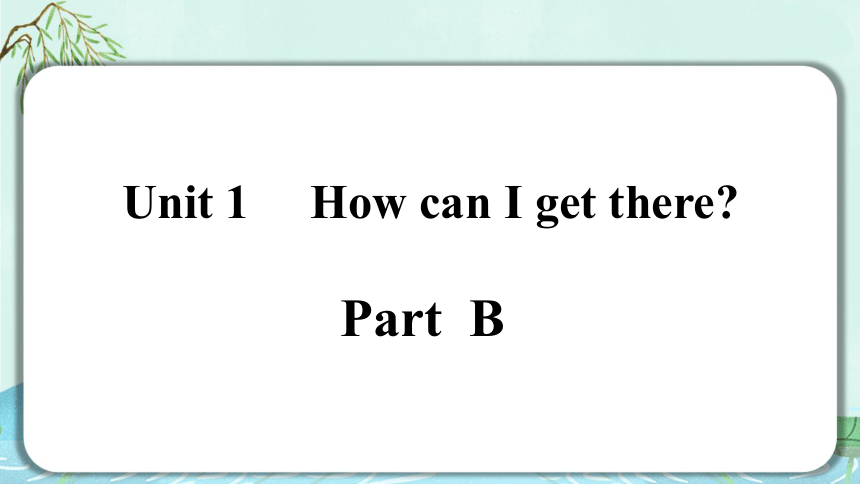 | |
| 格式 | pptx | ||
| 文件大小 | 2.6MB | ||
| 资源类型 | 教案 | ||
| 版本资源 | 人教版(PEP) | ||
| 科目 | 英语 | ||
| 更新时间 | 2023-05-31 09:05:32 | ||
图片预览

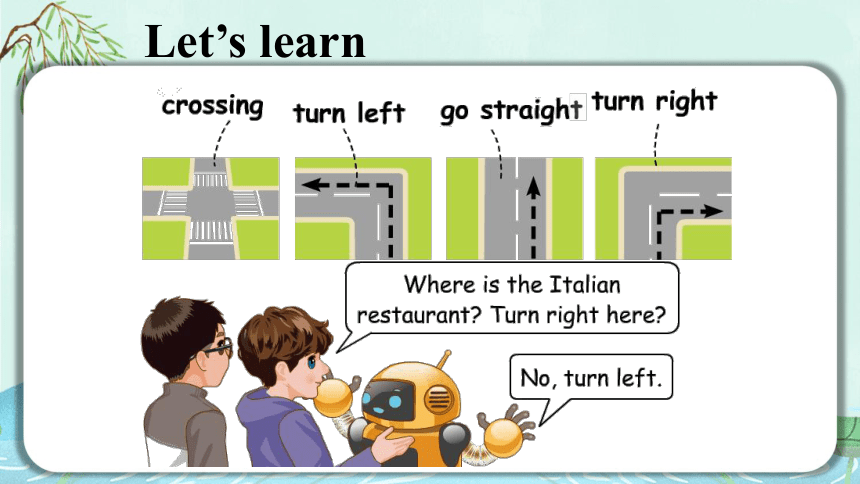

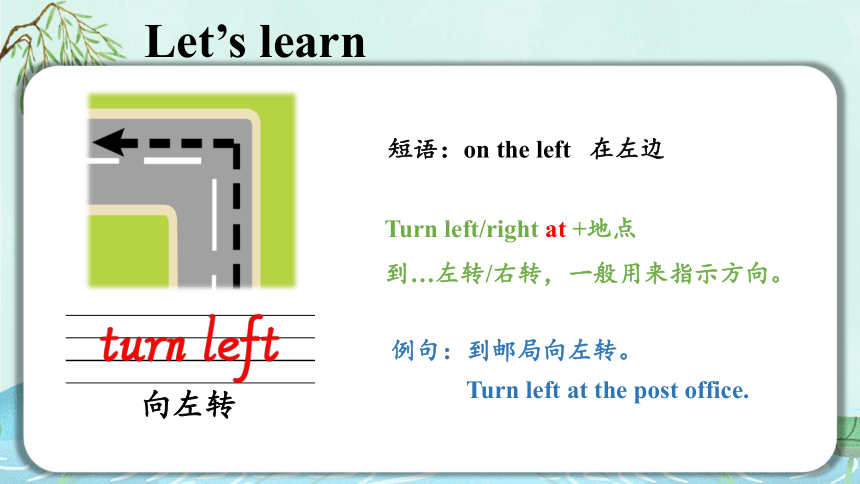
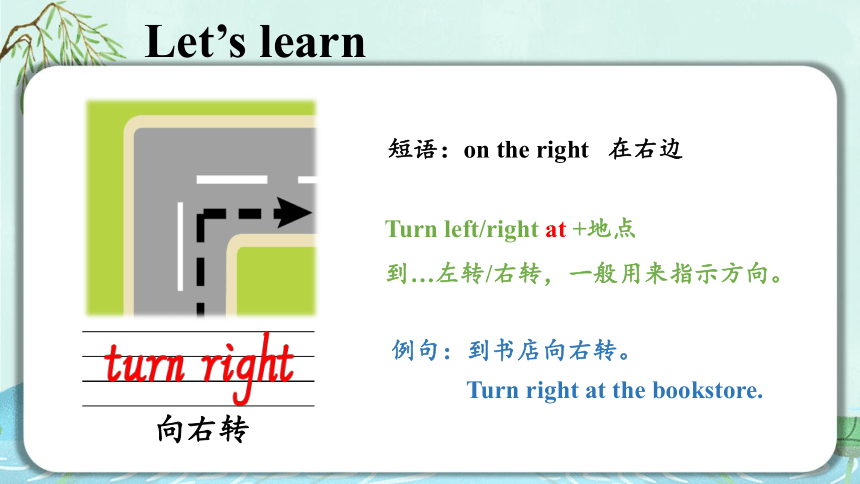
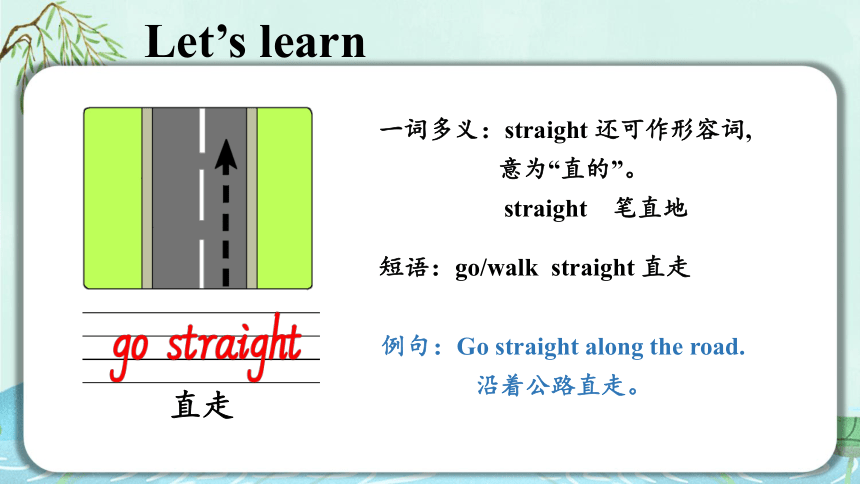
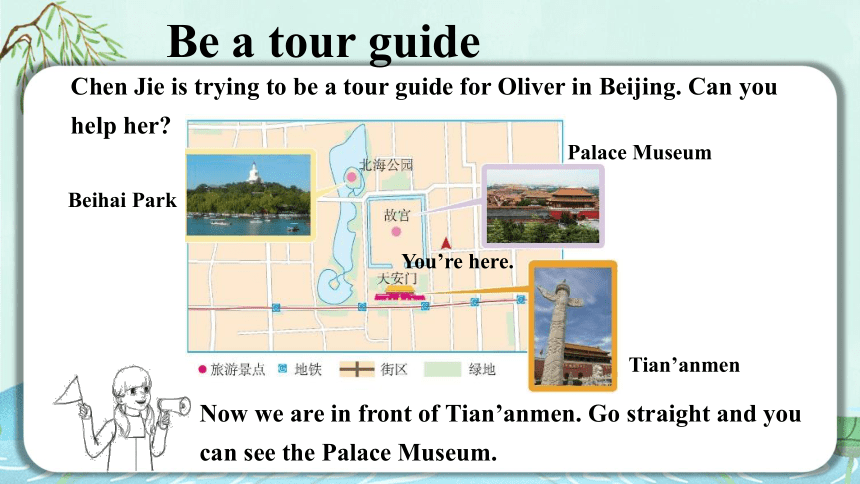
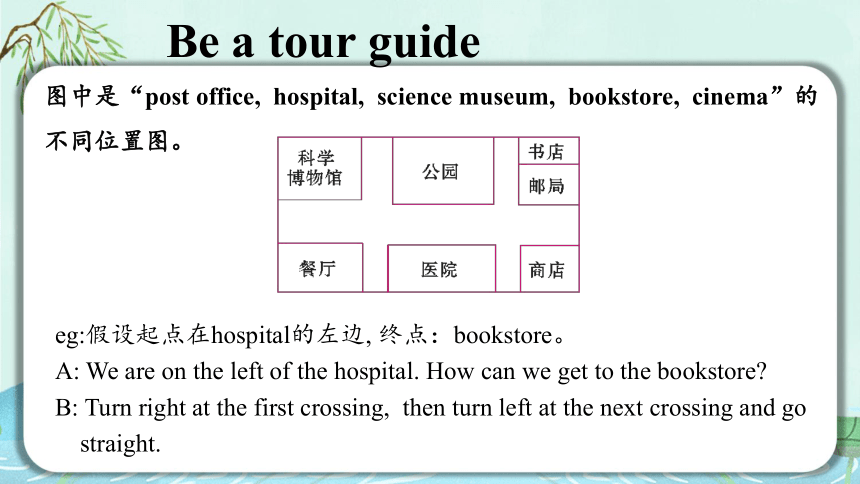
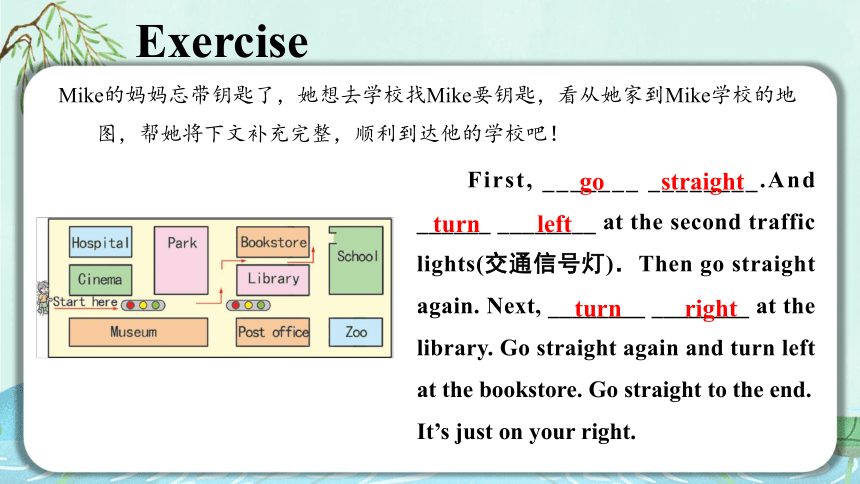
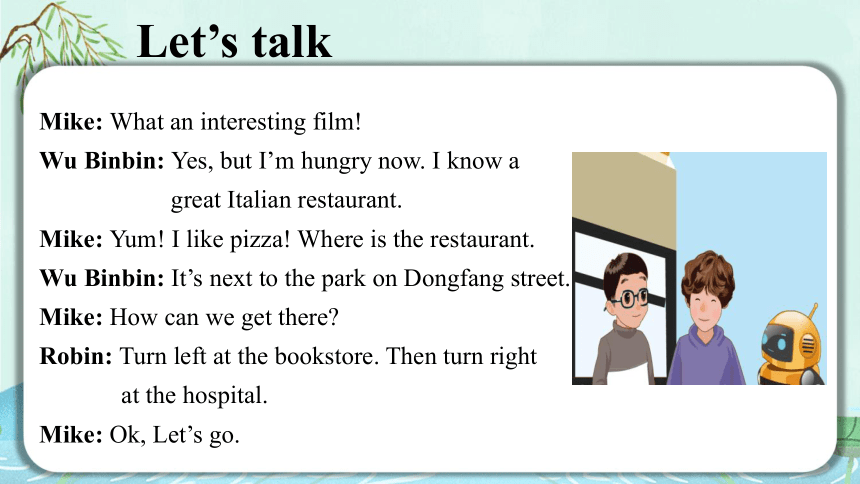
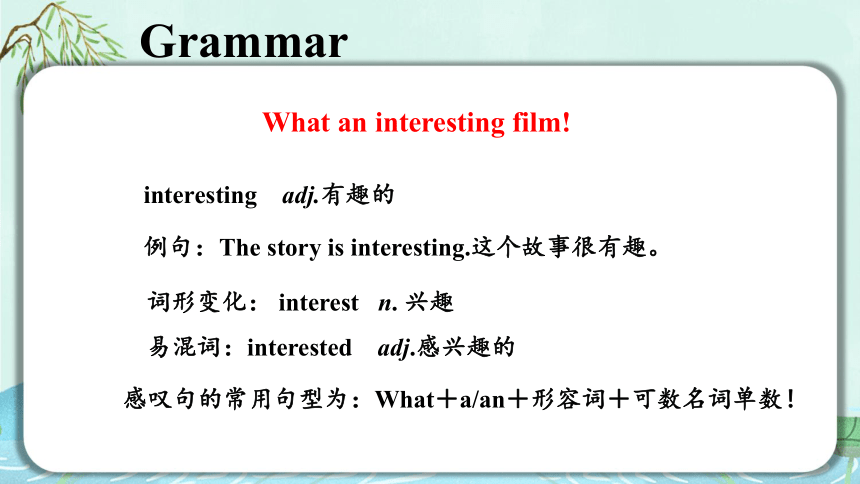
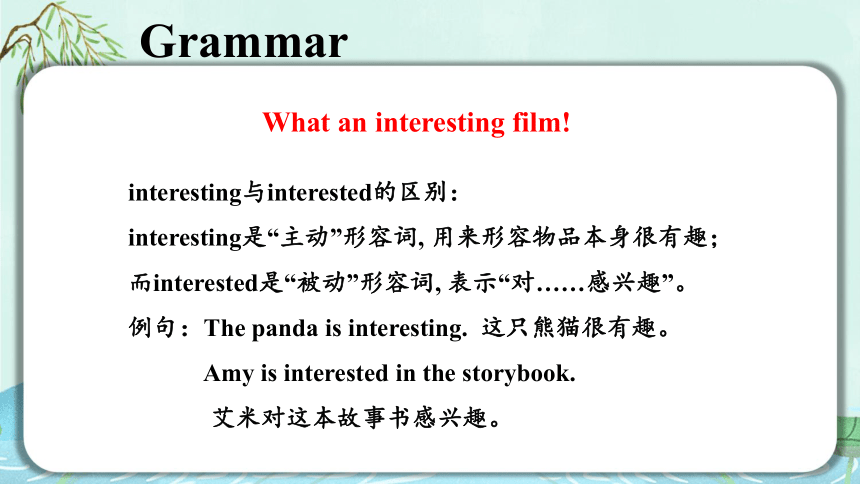
文档简介
(共34张PPT)
Unit 1 How can I get there
Part B
Let’s learn
Let’s learn
十字路口
短语:at the first crossing
在第一个十字路口
词形变化:cross v. 横过, 横穿
across prep. 横穿;横过
cross(横穿;横过)+ing=crossing(十字路口)
例句:Now I’m standing at the crossing.
我现在站在十字路口。
Let’s learn
短语:on the left 在左边
Turn left/right at +地点
到…左转/右转,一般用来指示方向。
例句:到邮局向左转。
Turn left at the post office.
向左转
Let’s learn
短语:on the right 在右边
Turn left/right at +地点
到…左转/右转,一般用来指示方向。
例句:到书店向右转。
Turn right at the bookstore.
向右转
Let’s learn
一词多义:straight 还可作形容词,
意为“直的”。
straight 笔直地
短语:go/walk straight 直走
例句:Go straight along the road.
沿着公路直走。
直走
Be a tour guide
Beihai Park
Palace Museum
Tian’anmen
You’re here.
Chen Jie is trying to be a tour guide for Oliver in Beijing. Can you help her
Now we are in front of Tian’anmen. Go straight and you can see the Palace Museum.
Be a tour guide
图中是“post office, hospital, science museum, bookstore, cinema”的不同位置图。
eg:假设起点在hospital的左边, 终点:bookstore。
A: We are on the left of the hospital. How can we get to the bookstore
B: Turn right at the first crossing, then turn left at the next crossing and go straight.
Exercise
Mike的妈妈忘带钥匙了,她想去学校找Mike要钥匙,看从她家到Mike学校的地图,帮她将下文补充完整,顺利到达他的学校吧!
First, _______ ________.And ______ ________ at the second traffic lights(交通信号灯).Then go straight again. Next, ________ ________ at the library. Go straight again and turn left at the bookstore. Go straight to the end. It’s just on your right.
go straight
turn left
turn right
Let’s talk
Mike: What an interesting film!
Wu Binbin: Yes, but I’m hungry now. I know a
great Italian restaurant.
Mike: Yum! I like pizza! Where is the restaurant.
Wu Binbin: It’s next to the park on Dongfang street.
Mike: How can we get there
Robin: Turn left at the bookstore. Then turn right
at the hospital.
Mike: Ok, Let’s go.
Grammar
What an interesting film!
interesting adj.有趣的
例句:The story is interesting.这个故事很有趣。
词形变化: interest n. 兴趣
易混词:interested adj.感兴趣的
感叹句的常用句型为:What+a/an+形容词+可数名词单数!
Grammar
What an interesting film!
interesting与interested的区别:
interesting是“主动”形容词, 用来形容物品本身很有趣;
而interested是“被动”形容词, 表示“对……感兴趣”。
例句:The panda is interesting. 这只熊猫很有趣。
Amy is interested in the storybook.
艾米对这本故事书感兴趣。
Grammar
Italian adj.意大利的
词形变化:Italy n.意大利
Italian还可作名词, 意为“意大利人”
例句:My pen pal is an Italian boy.
我的笔友是一个意大利男孩。
Grammar
How can we get there 我们怎么到那儿?
用法:该句是一个由how引导的特殊疑问句, 用于问路。how意为“怎样”, 用来询问做事情的方式, 位于句首, 引导特殊疑问句。
can是情态动词, 意为“能;能够”, 后跟动词原形。
get to+地点名词/get+地点副词, 表示“到达某地”。
常用句型是:How can I/we get (to)......
Grammar
How can we get there 我们怎么到那儿?
翻译:我怎样能到书店?
How can I get to the bookstore
翻译:我们怎么到那儿?
How can we get there
易错点
提示
get后面跟here/there/home等副词时, to要省略。
Grammar
How can we get there 我们怎么到那儿?
除了上面的句型, 问路还可以用下面的句型哟!
(1) Where is+地点名词 (……在哪里?)
例句:Where is the hospital 医院在哪儿?
(2) Which is the way to+地点名词 (哪条路是去……的?)
例句:Which is the way to the hospital 哪条路是去医院的?
(3) Can you tell me the way to+地点名词 (你能告诉我去...的路吗?)
例句:Can you tell me the way to the hospital 你能告诉我去医院的路吗?
Grammar
Turn left at the bookstore. 到书店左转。
turn v. 意为“转弯”, 表示改变方向。
例句:Turn around, please!请转圈!
turn作为名词, 意思是“转弯, 机会”。
例句:It’s your turn now. 现在轮到你了
表示“在某地向左转/向右转”的句型:Turn left/right at+地点.
Exercise
一、单项选择。
1. I have ________ doll.
A. a interesting B. an interesting C. an interested
2. My cousin comes from ______. He is ________.
A. Italian; Italy B. Italy; Italian C. Italian; Italian
3. ________ can we get to the zoo
A. What B. Where C. How
4. Can you ________ me
A. help B. helping C. to help
B
B
C
A
Exercise
一、单项选择。
5. —The zoo is far. How can we ________ there
—We can go by bus.
A. get B. getting C. get to
6. Turn right ________ the school.
A. at B. of C. on
A
A
Exercise
二、Read, choose and fill. 根据Let's try和Let's talk的内容,选择正确的词(组)补全短文。
Wu Yifan invited Mike to go to the 1.________. Mike should go to Main Street and then 2.__________ at the bookstore. The cinema is 3._________ the bookstore. They saw an interesting 4.______. Wu Yifan is 5.________ now. They want to go to a great Italian restaurant. Mike likes 6._______. It's yummy! But how can they 7.________ the restaurant They can turn left 8._____ the bookstore. Then 9.____________ at the hospital. It's next to the park 10.____ Dongfang Street.
next to, turn left, turn right, at, on, film, cinema, get to, pizza, hungry
cinema
turn left
next to
film
hungry
pizza
get to
at
turn right
on
Exercise
三、Ask and answer. 根据上下文,写出问句。
1. A: I don't feel well.________________________________
B: Yes, it's next to the science museum.
2. A: There is a new Italian restaurant nearby. The pizza there is very nice.
B: Really ________________
B: It's on the south of the library on Dongfang Street.
3. A: There are beautiful flowers everywhere in Songshan Lake. But _______________________
B: You can go by the No. 5 bus. Get off at the park. It's on your left.
Is there a hospital near here
Where is it
how can I get there
Exercise
四、Read and fill. 读一读,看一看,填一填。
1. A: Where is Beihai Park
B: ______ ______ at Willow school. Go straight and you can see it on your right.
2. A: I want to see pandas. How can I get to the ______
B: ______ ______ at our school. ___ _________. Then ______ ______ at the second crossing. It's on your left.
3. The Italian restaurant is __________ the Hexi Zoo and __________.
4. Beihai Park is __________ the hospital.
5. The library is ______ ______ Willow School.
Turn right
zoo
Turn left
Go
straight
turn
right
between
library
behind
next to
Read and write
Read and write
Read and write
Robin has GPS !
Wu Binbin’s grandpa gave Robin a new feature. He now has GPS. He can help the boys find
the Italian restaurant.
特征,特性
Read and write
Robin: We’re in front of the cinema. Let’s go
straight and turn left at the bookstore.
Follow me, please!
Read and write
Mike: Is it far
Robin: No. Now we are behind the hospital.
Let’s turn right and then turn right again.
Read and write
Mike: There is the restaurant!
Robin: My new GPS works!
Wu Binbin: Yes! I’ll tell Grandpa.
But let’s eat first.
I’m so hungry!
Read and write
Read and write
英语句子中语调的运用
语调是指人们说话时嗓音的高低、音调的升降。不同的语调可以表达不同的情感。英语句子的基本语调有两种:升调和降调。
(一)升调一般用于以下句式中:
1.表示提出疑问的一般疑问句。在句子的最后一个实词处上升, 其他部分保持平调。
例如: Do you like apples 你喜欢苹果吗?
Read and write
英语句子中语调的运用
2.表达鼓励或建议的祈使句。
例如:Let’s go together. 我们一起去吧。
3.表示不肯定、惊讶、委婉等语气的陈述句。
例如:This is your coat 这是你的外套?
Read and write
英语句子中语调的运用
(二)降调一般用于以下句式中:
1.陈述句用降调。
例如:We all like English. 我们都喜欢英语。
2.特殊疑问句一般用降调。
例如:Who have ten dollars 谁有10美元?
Read and write
英语句子中语调的运用
3.表示命令的祈使句用降调。
例如:Open your book. 打开你的书。
4.感叹句用降调。
例如:What a good girl she is!
她是一位多好的女孩呀!
Thank you
Unit 1 How can I get there
Part B
Let’s learn
Let’s learn
十字路口
短语:at the first crossing
在第一个十字路口
词形变化:cross v. 横过, 横穿
across prep. 横穿;横过
cross(横穿;横过)+ing=crossing(十字路口)
例句:Now I’m standing at the crossing.
我现在站在十字路口。
Let’s learn
短语:on the left 在左边
Turn left/right at +地点
到…左转/右转,一般用来指示方向。
例句:到邮局向左转。
Turn left at the post office.
向左转
Let’s learn
短语:on the right 在右边
Turn left/right at +地点
到…左转/右转,一般用来指示方向。
例句:到书店向右转。
Turn right at the bookstore.
向右转
Let’s learn
一词多义:straight 还可作形容词,
意为“直的”。
straight 笔直地
短语:go/walk straight 直走
例句:Go straight along the road.
沿着公路直走。
直走
Be a tour guide
Beihai Park
Palace Museum
Tian’anmen
You’re here.
Chen Jie is trying to be a tour guide for Oliver in Beijing. Can you help her
Now we are in front of Tian’anmen. Go straight and you can see the Palace Museum.
Be a tour guide
图中是“post office, hospital, science museum, bookstore, cinema”的不同位置图。
eg:假设起点在hospital的左边, 终点:bookstore。
A: We are on the left of the hospital. How can we get to the bookstore
B: Turn right at the first crossing, then turn left at the next crossing and go straight.
Exercise
Mike的妈妈忘带钥匙了,她想去学校找Mike要钥匙,看从她家到Mike学校的地图,帮她将下文补充完整,顺利到达他的学校吧!
First, _______ ________.And ______ ________ at the second traffic lights(交通信号灯).Then go straight again. Next, ________ ________ at the library. Go straight again and turn left at the bookstore. Go straight to the end. It’s just on your right.
go straight
turn left
turn right
Let’s talk
Mike: What an interesting film!
Wu Binbin: Yes, but I’m hungry now. I know a
great Italian restaurant.
Mike: Yum! I like pizza! Where is the restaurant.
Wu Binbin: It’s next to the park on Dongfang street.
Mike: How can we get there
Robin: Turn left at the bookstore. Then turn right
at the hospital.
Mike: Ok, Let’s go.
Grammar
What an interesting film!
interesting adj.有趣的
例句:The story is interesting.这个故事很有趣。
词形变化: interest n. 兴趣
易混词:interested adj.感兴趣的
感叹句的常用句型为:What+a/an+形容词+可数名词单数!
Grammar
What an interesting film!
interesting与interested的区别:
interesting是“主动”形容词, 用来形容物品本身很有趣;
而interested是“被动”形容词, 表示“对……感兴趣”。
例句:The panda is interesting. 这只熊猫很有趣。
Amy is interested in the storybook.
艾米对这本故事书感兴趣。
Grammar
Italian adj.意大利的
词形变化:Italy n.意大利
Italian还可作名词, 意为“意大利人”
例句:My pen pal is an Italian boy.
我的笔友是一个意大利男孩。
Grammar
How can we get there 我们怎么到那儿?
用法:该句是一个由how引导的特殊疑问句, 用于问路。how意为“怎样”, 用来询问做事情的方式, 位于句首, 引导特殊疑问句。
can是情态动词, 意为“能;能够”, 后跟动词原形。
get to+地点名词/get+地点副词, 表示“到达某地”。
常用句型是:How can I/we get (to)......
Grammar
How can we get there 我们怎么到那儿?
翻译:我怎样能到书店?
How can I get to the bookstore
翻译:我们怎么到那儿?
How can we get there
易错点
提示
get后面跟here/there/home等副词时, to要省略。
Grammar
How can we get there 我们怎么到那儿?
除了上面的句型, 问路还可以用下面的句型哟!
(1) Where is+地点名词 (……在哪里?)
例句:Where is the hospital 医院在哪儿?
(2) Which is the way to+地点名词 (哪条路是去……的?)
例句:Which is the way to the hospital 哪条路是去医院的?
(3) Can you tell me the way to+地点名词 (你能告诉我去...的路吗?)
例句:Can you tell me the way to the hospital 你能告诉我去医院的路吗?
Grammar
Turn left at the bookstore. 到书店左转。
turn v. 意为“转弯”, 表示改变方向。
例句:Turn around, please!请转圈!
turn作为名词, 意思是“转弯, 机会”。
例句:It’s your turn now. 现在轮到你了
表示“在某地向左转/向右转”的句型:Turn left/right at+地点.
Exercise
一、单项选择。
1. I have ________ doll.
A. a interesting B. an interesting C. an interested
2. My cousin comes from ______. He is ________.
A. Italian; Italy B. Italy; Italian C. Italian; Italian
3. ________ can we get to the zoo
A. What B. Where C. How
4. Can you ________ me
A. help B. helping C. to help
B
B
C
A
Exercise
一、单项选择。
5. —The zoo is far. How can we ________ there
—We can go by bus.
A. get B. getting C. get to
6. Turn right ________ the school.
A. at B. of C. on
A
A
Exercise
二、Read, choose and fill. 根据Let's try和Let's talk的内容,选择正确的词(组)补全短文。
Wu Yifan invited Mike to go to the 1.________. Mike should go to Main Street and then 2.__________ at the bookstore. The cinema is 3._________ the bookstore. They saw an interesting 4.______. Wu Yifan is 5.________ now. They want to go to a great Italian restaurant. Mike likes 6._______. It's yummy! But how can they 7.________ the restaurant They can turn left 8._____ the bookstore. Then 9.____________ at the hospital. It's next to the park 10.____ Dongfang Street.
next to, turn left, turn right, at, on, film, cinema, get to, pizza, hungry
cinema
turn left
next to
film
hungry
pizza
get to
at
turn right
on
Exercise
三、Ask and answer. 根据上下文,写出问句。
1. A: I don't feel well.________________________________
B: Yes, it's next to the science museum.
2. A: There is a new Italian restaurant nearby. The pizza there is very nice.
B: Really ________________
B: It's on the south of the library on Dongfang Street.
3. A: There are beautiful flowers everywhere in Songshan Lake. But _______________________
B: You can go by the No. 5 bus. Get off at the park. It's on your left.
Is there a hospital near here
Where is it
how can I get there
Exercise
四、Read and fill. 读一读,看一看,填一填。
1. A: Where is Beihai Park
B: ______ ______ at Willow school. Go straight and you can see it on your right.
2. A: I want to see pandas. How can I get to the ______
B: ______ ______ at our school. ___ _________. Then ______ ______ at the second crossing. It's on your left.
3. The Italian restaurant is __________ the Hexi Zoo and __________.
4. Beihai Park is __________ the hospital.
5. The library is ______ ______ Willow School.
Turn right
zoo
Turn left
Go
straight
turn
right
between
library
behind
next to
Read and write
Read and write
Read and write
Robin has GPS !
Wu Binbin’s grandpa gave Robin a new feature. He now has GPS. He can help the boys find
the Italian restaurant.
特征,特性
Read and write
Robin: We’re in front of the cinema. Let’s go
straight and turn left at the bookstore.
Follow me, please!
Read and write
Mike: Is it far
Robin: No. Now we are behind the hospital.
Let’s turn right and then turn right again.
Read and write
Mike: There is the restaurant!
Robin: My new GPS works!
Wu Binbin: Yes! I’ll tell Grandpa.
But let’s eat first.
I’m so hungry!
Read and write
Read and write
英语句子中语调的运用
语调是指人们说话时嗓音的高低、音调的升降。不同的语调可以表达不同的情感。英语句子的基本语调有两种:升调和降调。
(一)升调一般用于以下句式中:
1.表示提出疑问的一般疑问句。在句子的最后一个实词处上升, 其他部分保持平调。
例如: Do you like apples 你喜欢苹果吗?
Read and write
英语句子中语调的运用
2.表达鼓励或建议的祈使句。
例如:Let’s go together. 我们一起去吧。
3.表示不肯定、惊讶、委婉等语气的陈述句。
例如:This is your coat 这是你的外套?
Read and write
英语句子中语调的运用
(二)降调一般用于以下句式中:
1.陈述句用降调。
例如:We all like English. 我们都喜欢英语。
2.特殊疑问句一般用降调。
例如:Who have ten dollars 谁有10美元?
Read and write
英语句子中语调的运用
3.表示命令的祈使句用降调。
例如:Open your book. 打开你的书。
4.感叹句用降调。
例如:What a good girl she is!
她是一位多好的女孩呀!
Thank you
同课章节目录
